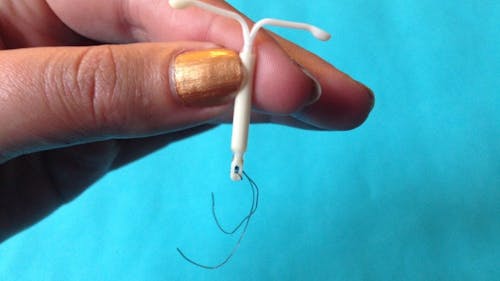Contraceptives 101, from the pill to the patch

We’ve all heard “safe sex is great sex” from our educators and parents. We sat through a class for a whole marking period in high school, and we see commercials advertising contraceptives. When Coach Carr from the movie "Mean Girls" told a gymnasium of students “Don’t have sex because you will get pregnant and die,” we all knew that advice was a bit ridiculous. Still, birth control is something we often overlook and don't dive into past sex ed in high school. The question is not if we know what safe sex is, but if we take all of our options for granted and ignore options that are potentially better for us. Once we become sexually active we all typically resort to two options — condoms and the pill. Although these methods are reliable and effective, they’re not for everyone. There are a lot more options out there and some that are even better or may work better with your body. On top of that, there are resources like Planned Parenthood to help pay for the cost of birth control. It’s essential and important to know your options so you can protect yourself as best as you can.
The Pill
Hormonal, 21-day birth control pills is the method all of us are familiar with. As effective as it is, many users find it is prone to failure. The pill has to be taken at the same time every single day, which can become a hassle, especially for forgetful people. When taken correctly, it’s still up to 99.9 percent effective. The pill works by stopping sperm from meeting an egg. The hormones found in birth control pills stop ovulation, and when there’s no egg for sperm to fertilize, pregnancy is pretty much impossible, according to Planned Parenthood.
The Patch
The patch is similar to the pill, but different in that you only have to ever think about it once a week. The patch works by releasing two chemicals into your body — estrogen and progestin — and the hormones released by the patch work by keeping the ovaries from releasing eggs. To use the patch, you stick the beige patch anywhere on your skin and change it once a week for three weeks. When used correctly, the patch has a 99.9-percent effectiveness rate.
Diaphragm
A diaphragm differs greatly from the pill and the patch. Lo Loestrin Fe explains that a diaphragm is a shallow, dome-shaped, latex cup with a flexible rim that’s inserted inside the vagina to cover the cervix, which then blocks the opening to the uterus so that sperm cannot reach an egg. A diaphragm is used only when you have sex, so its greatest benefit is that it is something you do not have to remember to take every day or change. A diaphragm has a 94-percent effectiveness rate when used correctly.
Shot
A shot, or injection, is another alternative to birth control. For this form of birth control, one must receive one shot every three months by a healthcare provider. The shot itself contains the hormone progestin which keeps the ovaries from producing eggs. This form of birth control is also very effective with a 99.9-percent effectiveness rate without having to be taken everyday, like the pill. You go to the doctor once every three months, totaling to four times a year.
Male Condom
Condoms were probably the first form of birth control you were introduced to. Most condoms are made of latex, but for those allergic to latex there are other condoms available such as those made from polyurethane, polyisoprene or lambskin. Although the effectiveness rate of a condom is 98 percent, it can always break which is a big downside. Although you can always run into that risk, it is recommended and a good idea to always use a condom along with contraceptives to prevent the spread of STDs and HIV.
IUD
An IUD, or intrauterine device, is a low-maintenance and highly-effective option for birth control. The small, T-shaped device is inserted in the uterus by a healthcare provider, so all it requires is one trip to the gynecologist. IUDs come in two types: one that contains copper and one that contains progestin. “Both types affect the way sperm move to keep them from joining an egg, and both change the lining of the uterus,” according to Lo Loestrin Fe. An IUD, once inserted, can last from 3 to 10 years and has a 99-percent effectiveness rate.
Ring
A ring is another form of birth control that is low maintenance. It’s a small, flexible ring that’s inserted into the vagina to release estrogen and progestin. Like a patch, the hormones work by keeping the ovaries from releasing eggs. To use the ring, you insert the it into the vagina and keep it in there for three weeks and take it out for one week. You repeat this routine monthly. When used correctly, the ring has a 99-percent effectiveness rate.
Female Condom
A female condom is something that is not usually acknowledged during discussions about birth control, but that doesn’t mean it’s significantly less effective than the others. The plastic, pouch-like device is inserted into the vagina, and the flexible rings at each end help it to stay in place during sex. Like a male condom, it’s only inserted right before sex and can prevent the spread of STDs. When used correctly, it has a 95-percent effectiveness rate.
It’s cliche, but true: safe sex is great sex. Since you don’t have to worry about unwanted pregnancy or STIs after using protection, you can enjoy sex stress-free. With so many forms of birth control available, it can be overwhelming to decipher between them and decide which is best for us. We must remember though, that we are all different people with different bodies and routines. Protect yourself and do what is best for your life and body.



